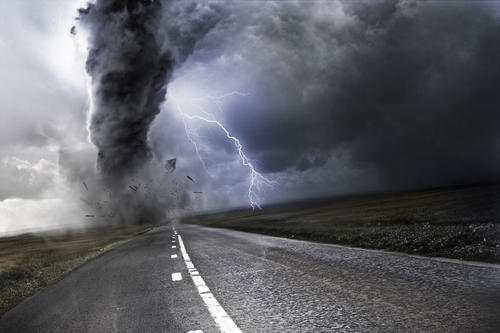Europe Must Prepare for Storms and Heat Waves
Meteorologists from Freie Universität contribute to new report on extreme weather phenomena
Jul 02, 2014
Tornadoes like this one in the UK, as well as other extreme weather phenomena, will likely cause more serious damage in the future, even in Central European countries.
Image Credit: James Thew - Fotolia
Flooding in June, hail storms in August, hurricane-force winds in December: 2013 brought various weather extremes for Germany, all within a few months. Insurers paid about seven billion euros to cover the damage. Experts warn that in the future, costly cleanup work could be needed even more often.
A new report from the Norwegian Meteorological Institute and the European Academies Science Advisory Council (EASAC) recommends that Germany and its neighboring countries prepare for heavy storms and flooding. The flooding on the Elbe River in 2002 and 2013 could be followed over the next few years and decades by more frequent flooding disasters. Europe, especially Southern Europe, also needs to gear up for longer, more intense heat waves.
The report’s authors include meteorology professors Ulrich Cubasch and Uwe Ulbrich of Freie Universität. Their research focuses particularly on the frequency and intensity expected of future storms in Europe.
The report, which the meteorologists submitted to the European Commission in Brussels in December, is based on the assessment reports issued in 2007 and 2013 by the Intergovernmental Panel on Climate Change (IPCC) – to which Freie Universität was also a leading contributor – as well as further studies and climate models. It addresses the changes attributable to the rising concentrations of greenhouse gases, and aims to help politicians develop strategies for coping with changes in the weather.
This is important because so far, governments have only prepared for immediate threats. The authors write that “policy communities within the EU have begun to consider appropriate responses to these changes,” and that there are also EU initiatives on specific challenges. However, a comprehensive adjustment strategy is still waiting to be mapped out.
So far, insurers have been the ones pushing many new developments. Cubasch says, “Insurance companies play a big role in things like raising embankments and levees, enlarging rain gutters, and adjusting how roofs are built.” These measures reduce the damage sustained in flooding and storms.
The EASAC report analyzes various data, including data compiled by the insurance industry. To do this, the authors used a model, developed at Freie Universität, of the development of financial losses resulting from storms. It forecasts a huge increase, especially in Germany – if building standards are not adjusted, that is. In that case, the average damage totals will rise by more than 25 percent by the end of the 21st century, the experts warn – even without factoring in further increases due to growing prosperity and the rising value of real estate.
At the same time, storms will not only strike Central Europe more often, but also with greater force, the scientists predict. This is ultimately a result of the greenhouse effect, Ulbrich explains. “In the simulations, we can observe a change in the ocean circulation in the North Atlantic, west of Europe. This reinforces the temperature contrast there, with a somewhat lower temperature increase in the north and a sharper one in the south contributing to the intensity of low pressure zones.”
As a result, the scientists say, heavy precipitation and winter storms will become more common in Germany and the neighboring countries. In general, the report attests to a tendency toward more pronounced versions of existing climatic conditions: Northern and Central Europe will see more rain than before, while drier areas of Southern Europe receive less. As a result, the authors recommend that the healthcare sector ramp up efforts aimed at heat-related illnesses.
For the agriculture sector all over Europe, the authors write that both drought and storms will become a challenge. The report also says that extreme winter storms Christian and Xaver, which swept across northwestern Europe in late 2013, showed once again that critical pieces of the infrastructure, such as power lines and public transit, must be adjusted better to accommodate climate conditions.
The report repeatedly stresses how important it is for the European Union to develop a joint strategy to limit the damage caused by extreme weather events. To accomplish that, the individual countries need to fit their existing concepts together better. For example, regulations on flood prevention and protection vary, in some cases significantly, and their effectiveness has not been studied adequately. But the experts believe flooding is one area where international planning is particularly needed, along with comprehensive concepts for increased climate research, better access to information on damage, and extensive international networking in the research community.
Limiting the damage alone is not enough, however; the authors also call on European decision makers to continue fighting the causes of global warming all over the world. Otherwise, we will have to be prepared for further natural disasters, even in our latitudes. Cubasch warns, “The sharper the rise in emissions of greenhouse gases, the more likely extreme flooding, droughts, and storms become.”
Further Information
- Prof. Dr. Ulrich Cubasch, Freie Universität Berlin, Institute of Meteorology, Email: cubasch@zedat.fu-berlin.de
- Meteorologist Uwe Horst Ulbrich, Freie Universität Berlin, Institute of Meteorology, Email: u.h.ulbrich@met.fu-berlin.de

